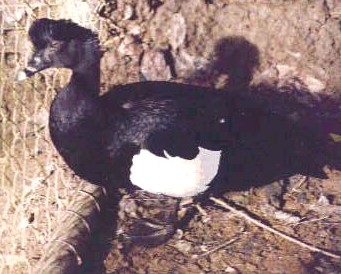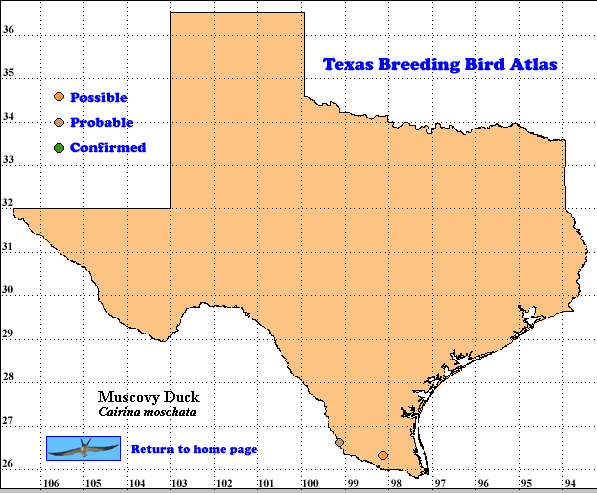Muscovy Ducks are most often seen in the United States as domesticated bird, often with multicolored plumages. Many are descended from individuals taken to Europe from the New World centuries ago and bred for the fancy poultry trade. Muscovy Ducks are the only domesticated ducks not derived from wild Mallards (Anas platyrhynchos). These large birds, males often weigh up to 6.5 kg (15 lbs), retain the clawed feet used by wild birds to perch and roost in trees (Oklahoma State Univ. Dept. Animal Sci. 2002).
Wild Muscovy Ducks can be distinguished by their wary behavior, flying silently from their perches high in riparian trees at the first approach of humans. They are heavy-bodied with a goose-like flight (Stiles and Skutch 1989, Howell and Webb 1995, RCT).
Mitochondrial DNA sequencing studies indicate Muscovy Ducks are only distantly related to dabbling ducks, but appear closely related to Wood Ducks (Aix sponsa, Johnson and Sorenson 1999). These two species use similar habitats and nest sites and eat a wide variety of foods including grains, fruits, nuts, aquatic vertebrates, small fish, insects and crabs (Howell and Webb 1995),
DISTRIBUTION. During the 1987-1992 field work seasons of the TBBA project, atlasers found breeding evidence for Muscovy Ducks at 2 areas in the South Texas Brush Country region (see the region map in Lockwood and Freeman [2004]) in extreme south Texas. Latilong-quad 26099-E1 had one probable and one possible record and 26098-D1 had a possible breeding site. This duck was first observed in Texas in Decenter 1984 and a small population became establish below Falcon Dam, in Starr County. Breeding was first reported in July, 1994 near Bentsen-Rio Grande Valley State Park in Hidalgo County. Most of the Texas population apparently occurs in Zapata, Starr and Hidalgo counties with some wild birds also found in Webb County (Brush and Eitniear 2002).
Muscovy Ducks are also resident along parts of both coasts of Mexico, Central America and the lowlands of both coasts of South America to northern Argentina and Ecuador (Stiles and Skutch 1989, Howell and Webb 1995, Am, Ornithol. Union 1998).
SEASONAL OCCURRENCE. Muscovy Ducks are resident throughout their range (Am, Ornithol. Union 1998). Breeding apparently occurs in summer (Brush and Eitniear 2002).
BREEDING HABITAT. Muscovy Ducks reside in riparian areas near freshwater lakes, ponds, rivers and marshes and also in coastal mangroves. These ducks nest in natural cavities in large trees, nest boxes and sometimes in other cavities (Eitniear et al. 1999). Females lay clutches of 8-10, or even 14, greenish white or white eggs. Domesticated Muscovy Ducks incubate their eggs for 35 days. Males are often polygamous (Stiles and Skutch 1989, Howell and Webb 1995, Am, Ornithol. Union 1998, Oklahoma State Univ. Dept. Animal Sci. 2002).
STATUS. Muscovy Ducks are rare and local in Texas in the lower Rio Grande valley (Lockwood and Freeman 2004). In Mexico they are uncommon to rare and are heavily hunted. In Costa Rica and Panama the species is uncommon and local (Ridgely and Gwynne 1976, Stiles and Skutch 1989, Howell and Webb 1995). Loss of nest cavities is also a problem as large trees are cut in riparian areas.The erection of 3000 nest boxes in eastern Mexico in the 1970s and early 1980s by Ducks Unlimited (Brush and Eitniear 2002) was intended to aid cavity-nesting ducks. Interestingly the first sighting of Muscovys in Texas came shortly after this action.
Literature cited.
American Ornithologists’ Union. 1998. Checklist of North American birds, 7thed. Am, Ornithol. Union, Washington, DC.
Brush, T. and J. C. Eitniear. 2002. Status and recent nesting of Muscovy Duck (Cairina moschata) in the Rio Grande valley, Texas. Bull. Texas Ornithol. Soc. 35: 12-14.

